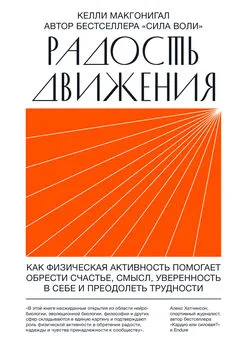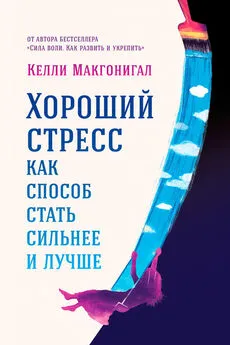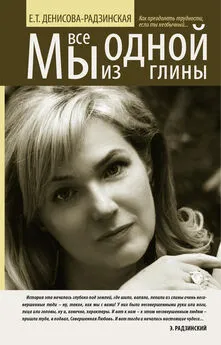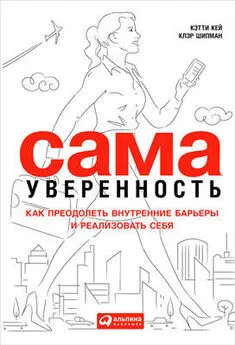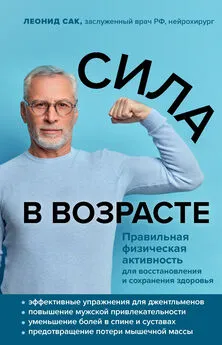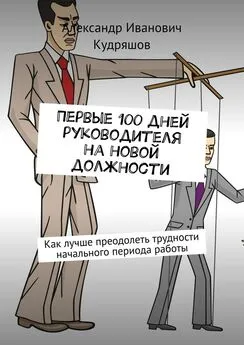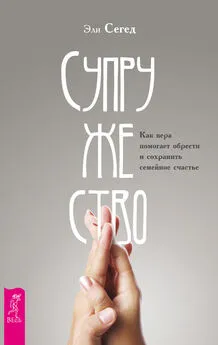Келли Макгонигал - Радость движения. Как физическая активность помогает обрести счастье, смысл, уверенность в себе и преодолеть трудности
- Название:Радость движения. Как физическая активность помогает обрести счастье, смысл, уверенность в себе и преодолеть трудности
- Автор:
- Жанр:
- Издательство:неизвестно
- Год:2021
- Город:Москва
- ISBN:978-5-00169-107-5
- Рейтинг:
- Избранное:Добавить в избранное
-
Отзывы:
-
Ваша оценка:
Келли Макгонигал - Радость движения. Как физическая активность помогает обрести счастье, смысл, уверенность в себе и преодолеть трудности краткое содержание
Радость движения. Как физическая активность помогает обрести счастье, смысл, уверенность в себе и преодолеть трудности - читать онлайн бесплатно ознакомительный отрывок
Интервал:
Закладка:
На занятии все работали в сложном для себя режиме. Для кого-то это означало пробежать километр за четыре минуты, для кого-то – пройти километр за десять минут. Флеммер с радостью обнаружила, что на групповом занятии та же физическая активность, которую она вела самостоятельно, ощущается совсем иначе. В классе ей казалось, будто вся группа стремится к общей цели и прикладывает не только индивидуальные, но и общие усилия. Ее любимая часть занятия – когда тренер призывает к самой интенсивной, пиковой части тренировки, а она смотрит на занимающегося на соседней дорожке и говорит: «Давай сделаем это!» «Когда двенадцать человек рядом выкладываются на полную, это трогает меня до слез».
В студии зеркальные стены, и недавно на тренировке Флеммер встретилась взглядом с мужчиной, который занимался на дорожке позади нее. «В тот момент мы ощутили абсолютное единение и жестами подбадривали друг друга. Меня переполнило чувство благодарности. Благодарности за то, что он есть, за то, что пришел на тренировку; за способность людей чувствовать взаимосвязь». Это чувство после занятия не исчезает. «Я стала смелее, чаще смотрю людям в глаза и первой вступаю в разговор, – рассказала Ники. – Групповые занятия помогли мне осознать, что все хотят общаться. Даже если люди этого не признают, им нравится, когда им улыбаются».
Конец ознакомительного фрагмента.
Текст предоставлен ООО «ЛитРес».
Прочитайте эту книгу целиком, купив полную легальную версию на ЛитРес.
Безопасно оплатить книгу можно банковской картой Visa, MasterCard, Maestro, со счета мобильного телефона, с платежного терминала, в салоне МТС или Связной, через PayPal, WebMoney, Яндекс.Деньги, QIWI Кошелек, бонусными картами или другим удобным Вам способом.
Сноски
1
Daniel M. Wolpert, Zoubin Ghahramani, and J. Randall Flanagan. “Perspectives and Problems in Motor Learning.” Trends in Cognitive Sciences 5, № 11 (2001): 487–494.
2
Doug Anderson. “Recovering Humanity: Movement, Sport, and Nature.” Journal of the Philosophy of Sport 28, № 2 (2001): 140–150.
3
Alexander Bain. The Senses and the Intellect. London: John W. Parker & Son, 1855.
4
Vybarr Cregan-Reid. Footnotes: How Running Makes Us Human (New York: Thomas Dunne Books/St. Martin’s Press, 2017).
5
Scott Dunlap, “Understanding the Runner’s High.” January 8, 2005; http://www.atrailrunnersblog.com/2005/01/understanding-runners-high.html.
6
1 миля = 1,60934 км, то есть на десятом километре. Прим. ред.
7
Dan Sturn. “How Humans Fly.” In Garth Battista, ed., The Runner’s High: Illumination and Ecstasy in Motion (Halcottsville, NY: Breakaway Books, 2014), 178.
8
https://www.reddit.com/r/running/comments/1nbmjc/what_does_the_runners_high_actually_feel_like/.
9
Stephanie Case. “Riding the Runner’s Highs and Braving the Lows.” March 10, 2011; https://ultrarunnergirl.com/2011/03/10/highs_and_lows/.
10
Dennis M. Bramble and Daniel E. Lieberman. “Endurance Running and the Evolution of Homo.” Nature 432, № 7015 (2004): 345–352.
11
Херман Понтцер поделился со мной этой историей в беседе. Вы можете прослушать ее здесь: https://www.storycollider.org/stories/2016/10/22/herman-pontzer-burning-calories.
12
David A. Raichlen et al. “Physical Activity Patterns and Biomarkers of Cardiovascular Disease Risk in Hunter-Gatherers.” American Journal of Human Biology 29, № 2 (2017): DOI: 10.1002/ajhb.22919.
13
Jared M. Tucker, Gregory J. Welk, and Nicholas K. Beyler. “Physical Activity in US Adults: Compliance with the Physical Activity Guidelines for Americans.” American Journal of Preventive Medicine 40, № 4 (2011): 454–461; Vijay R. Varma et al. “Re-evaluating the Effect of Age on Physical Activity over the Lifespan.” Preventive Medicine 101 (2017): 102–108.
14
Raichlen et al. “Physical Activity Patterns and Biomarkers of Cardiovascular Disease Risk in Hunter-Gatherers.”
15
Stephanie A. Hooker and Kevin S. Masters. “Purpose in Life Is Associated with Physical Activity Measured by Accelerometer.” Journal of Health Psychology 21, № 6 (2016): 962–971.
16
Neal Lathia et al. “Happier People Live More Active Lives: Using Smartphones to Link Happiness and Physical Activity.” PLoS One 12, № 1 (2017): e0160589.
17
Jaclyn P. Maher et al. “Daily Satisfaction with Life Is Regulated by Both Physical Activity and Sedentary Behavior.” Journal of Sport and Exercise Psychology 36, № 2 (2014): 166–178.
18
Romano Endrighi, Andrew Steptoe, and Mark Hamer. “The Effect of Experimentally Induced Sedentariness on Mood and Psychobiological Responses to Mental Stress.” The British Journal of Psychiatry: The Journal of Mental Science 208, № 3 (2016): 245–251.
19
Meghan K. Edwards and Paul D. Loprinzi. “Experimentally Increasing Sedentary Behavior Results in Increased Anxiety in an Active Young Adult Population.” Journal of Affective Disorders 204 (2016): 166–173; Meghan K. Edwards and Paul D. Loprinzi. “Effects of a Sedentary Behavior – Inducing Randomized Controlled Intervention on Depression and Mood Profile in Active Young Adults.” Mayo Clinic Proceedings 91, № 8 (2016): 984–998; Meghan K. Edwards and Paul D. Loprinzi. “Experimentally Increasing Sedentary Behavior Results in Decreased Life Satisfaction.” Health Promotion Perspectives 7, № 2 (2017): 88–94.
20
Tim Althoff et al. “Large-Scale Physical Activity Data Reveal Worldwide Activity Inequality.” Nature 547, № 7663 (2017): 336–339.
21
См.: Bramble and Lieberman. “Endurance Running and the Evolution of Homo”; Herman Pontzer. “Economy and Endurance in Human Evolution.” Current Biology 27, № 12 (2017): R613–621; Jay Schulkin, “Evolutionary Basis of Human Running and Its Impact on Neural Function.” Frontiers in Systems Neuroscience 10 (2016): 59.
22
Herman Pontzer. “The Exercise Paradox.” Scientific American, February 2017. Цитата на с. 27.
23
Tiina Saanijoki et al. “Opioid Release After High-Intensity Interval Training in Healthy Human Subjects.” Neuropsychopharmacology 43, № 2 (2018): 246–254; Henning Boecker et al., “The Runner’s High: Opioidergic Mechanisms in the Human Brain.” Cerebral Cortex 18, № 11 (2008): 2523–2531.
24
Patrick M. Whitehead. “The Runner’s High Revisited: A Phenomenological Analysis.” Journal of Phenomenological Psychology 47, № 2 (2016): 183–198.
25
David A. Raichlen et al., “Exercise-Induced Endocannabinoid Signaling Is Modulated by Intensity.” European Journal of Applied Physiology 113, № 4 (2013): 869–875.
26
David A. Raichlen et al. “Wired to Run: Exercise-Induced Endocannabinoid Signaling in Humans and Cursorial Mammals with Implications for the ‘Runner’s High.’” Journal of Experimental Biology 215, № 8 (2012): 1331–1336.
27
Angelique G. Brellenthin et al. “Endocannabinoid and Mood Responses to Exercise in Adults with Varying Activity Levels.” Translational Journal of the American College of Sports Medicine 2, № 21 (2017): 138–145; E. Heyman et al. “Intense Exercise Increases Circulating Endocannabinoid and BDNF Levels in Humans – Possible Implications for Reward and Depression.” Psychoneuroendocrinology 37, № 6 (2012): 844–851; P. B. Sparling et al. “Exercise Activates the Endocannabinoid System.” NeuroReport 14, № 17 (2003): 2209–2211; M. Feuerecker et al. “Effects of Exercise Stress on the Endocannabinoid System in Humans Under Field Conditions.” European Journal of Applied Physiology 112, № 7 (2012): 2777–2781.
28
Цитируется по: Elizabeth Cassidy, Sandra Naylor, and Frances Reynolds. “The Meanings of Physiotherapy and Exercise for People Living with Progressive Cerebellar Ataxia: An Interpretative Phenomenological Analysis.” Disability and Rehabilitation 40, № 8 (2018): 894–904.
29
Роман Стивена Кинга и одноименный фильм ужасов; в центре сюжета – собака по имени Куджо, заболевшая бешенством. Прим. пер.
30
David Fleming. “Slow and Steady Wins the Planet.” ESPN, February 11, 2011; http://www.espn.com/espn/news/story?id=6110087.
31
Adharanand Finn. “Why We Love to Run.” The Guardian, February 5, 2013; https://www.theguardian.com/lifeandstyle/the-running-blog/2013/feb/05/why-we-love-to-run.
32
Robin Christensen et al. “Efficacy and Safety of the Weight-Loss Drug Rimonabant: A Meta-Analysis of Randomised Trials.” The Lancet 370, № 9600 (2007): P1706–1713.
33
Hamilton Morris. “New Frontiers of Sobriety.” Vice, July 31, 2009; https://www.vice.com/en_us/article/kwg8ny/new-frontiers-of-sobriety-984-v16n8.
34
Brooke K. Keeney et al. “Differential Response to a Selective Cannabinoid Receptor Antagonist (SR141716: Rimonabant) in Female Mice from Lines Selectively Bred for High Voluntary Wheel-Running Behaviour.” Behavioural Pharmacology 19, № 8 (2008): 812–820; Sarah Dubreucq et al. “Ventral Tegmental Area Cannabinoid Type-1 Receptors Control Voluntary Exercise Performance.” Biological Psychiatry 73, № 9 (2013): 895–903.
Читать дальшеИнтервал:
Закладка:
